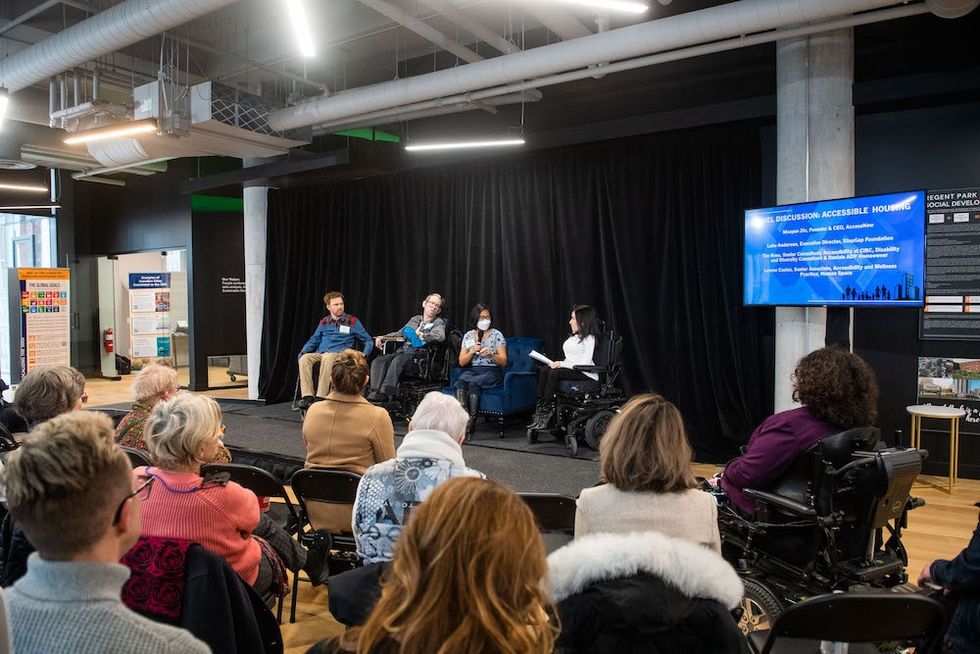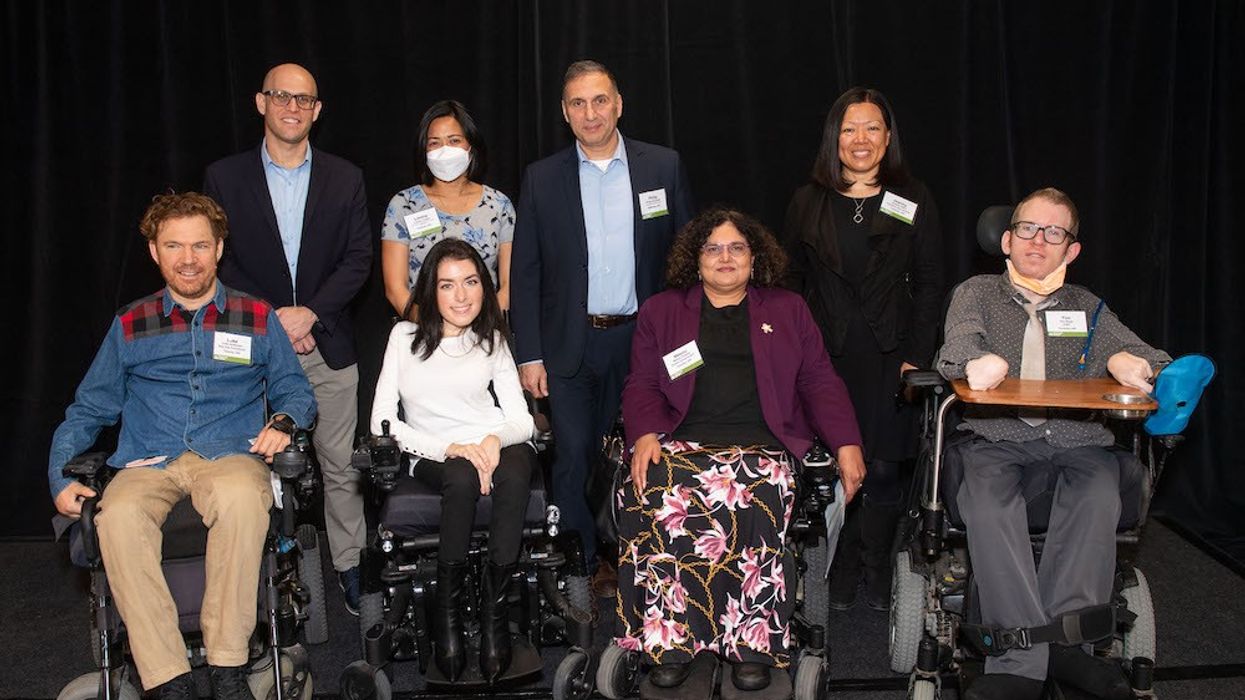It’s time for the supply of accessible housing to meet demand. That's more than a nice idea -- it’s an incredibly overdue necessity and a fundamental human right.
According to Statistics Canada, in 2017, 6.2M (22%) Canadians aged 15 years and over identified as having one or more disabilities. More than half (55.8%) reported having a physical disability. Among those with physical disabilities, 44.9% required at least one type of aid or assistive device or an accessibility feature within their home. This could include ramps, a walk-in bath or shower, lift device or elevator, lowered counters, or automatic doors.
Yet, countless Canadians living with disabilities face significant barriers related to homes and facilities. Tim Rose, Senior Consultant, Accessibility at CIBC, says it was virtually impossible to find an accessible rental in Toronto, despite extensive searches; he and his wife lived for years without a bathroom door in order to accommodate his mobility device and shower chair. As the population continues to age, the challenges will continue to increase on the accessible living front.
But times are (finally) changing.
Yesterday, Canada’s top real estate development and accessibility leaders officially launched the Accelerating Accessibility Coalition (AAC) at an event at the World Urban Pavilion in Regent Park -- Powered by Daniels. The AAC is a first-of-its-kind coalition that is challenging home builders to make physical accessibility a greater priority as they build the millions of new homes needed across Canada in the next decade. The AAC is built on the belief that accessible housing benefits everyone, and that a sign of an inclusive and prosperous country is where people of all ages and abilities can participate fully in society. This includes having access to barrier-free homes.
ULI (Urban Land Institute)’s Toronto District Council will serve as the coalition secretariat and leverage its platform as one of the largest chapters in the global ULI network to shine a spotlight on this issue and mobilize change.
“Contributing ULI’s voice and platform as the backbone of the coalition to elevate accessibility is very much in keeping with our mission to convene, converse and transform the future of city-building across the Golden Horseshoe and the world,” said Richard Joy, Executive Director of ULI Toronto. “As home of the industry, we look forward to connecting people with a diversity of opinions and backgrounds to talk about accessibility and build pathways to better outcomes for people of all ages and abilities.”
Current members of the AAC include The Daniels Corporation, Accessibility Standards Canada, AccessNow, Accessible Housing Network, Cadillac-Fairview, CivicAction, Community Living Toronto, Building Industry and Land Development Association (BILD), CNIB Frontier Accessibility, Rick Hansen Foundation, StopGap Foundation, ULI Toronto, and many more.
The Daniels Corporation has been building new homes in communities for nearly 40 years. About seven years ago, the company noticed they were getting numerous requests from people to make their homes more accessible, said Chief Operating Officer Jake Cohen. “We discovered there was a significant gap between the Ontario Building Code’s standards on what constitutes barrier-free living spaces and what homeowners and tenants actually need to make their homes livable,” said Cohen. “People with mobility devices felt excluded from the ability to live in our new and existing communities.”
So, Daniels set out to go above and beyond the living standards outlined Ontario Building Code, teaming up with people in the accessibility community who could offer lived experiences, conducting research, and engaging in consultations.
“We discovered that livable, accessible suites were an anomaly and something the housing industry was in dire need of,” said Cohen. So, the group launched their Daniels Accessible Design Program (ADP) to improve the quality of life for its future residents, partnering with influential organizations in the accessibility space, including AccessNow, and the Rick Hanson foundation. “The AAC coalition is another step to do the right thing now, rather than waiting until we’re required to do so,” said Cohen. “We are taking a leadership role to rectify this situation.”

In about 15% of its units, Daniels buildings offer homeowners suites that feature things like rolling showers, rollout balconies, accessible kitchens (keeping in mind things like turning radiuses), wider doorframes, and lowered light switches and power outlets at seated level. In common areas, buildings feature things like accessible concierge desks with roll-up openings and automatic door openers everywhere, including automatic garbage shoot doors.
Cohen says Daniels is in the process of extending the program into its low-rise communities, researching things like stairwell width, wheelchair ramping access, and proper sizing of units.
At the official AAC launch event yesterday -- which included remarks from industry change-makers and a panel discussion led by Maayan Ziv, Founder and CEO of AccessNow -- AAC members called on their peers to follow suit. They encouraged industry organizations and leaders to step up, join the coalition, and commit to the learning that will lead to building new housing that is accessible to people of all ages and abilities.
To simplify the process for builders, the ACC also launched the Accessibility Toolbox, highlighting the work and best practices of participating coalition partners including standards, certifications, expert services, and connections to organizations representing people with disabilities. The toolbox will serve as an aggregator that informs and inspires home builders to design and build accessible homes without waiting for building codes or legislation to catch up to the current and evolving needs of Canadians. The toolbox includes recommended actions that organizations can immediately take that will guide them on their commitment to accessibility.
Accessibility Standards Canada is a federal corporation responsible for developing accessibility standards and funding accessibility standards research. They are supporting the creation of the coalition and partnering with the AAC while contributing to the Accessibility Toolbox.
“We have an opportunity to be part of the solution, and use the platform we have with Daniels colleagues to promote awareness and understanding,” said David Wilkes, President and CEO of BILD said yesterday. He admitted that he "didn’t know what [he was] talking about," being an able-bodied person. “If I accept that, and try to experience things through other people’s eyes, we can change that," he continued. "BILD will commit to ensure that the toolkit development will advance the conversation so that this isn’t something you think of after the fact, but part of the planning process.”
Aside from the fundamental human rights and human dignity factors, giving greater priority to accessibility can also make good financial sense. New buildings can achieve Rick Hansen Foundation Accessibility CertificationTM (RHFAC) at no additional cost compared to National or Ontario building code through thoughtful planning and design, according to research compiled in 2020 by the Rick Hansen Foundation and HCMA Architecture + Design.
Mayor Tory is a vocal supporter of the initiative. “Torontonians with disabilities should not face barriers to safe and accessible housing," said Tory. "As we continue to push forward with getting more housing built across the city, accessibility must be a priority. I applaud the work of the Accelerating Accessibility Coalition for their commitment to this issue, and I encourage others to join this effort. Everyone has a role to play in making our city welcoming and accessible for all residents who choose to live here.”
Over the course of the next year, the AAC will host events, webinars and workshops that continue to educate, drive awareness and encourage accountability in the industry.
“There’s 16 members so far, and we want more people to join,” said panelist Luke Anderson, Executive Director, StopGap Foundation. “That takes education and stepping into some vulnerability and knowing that it’s ok not to know. I didn’t know at one point in my life.” Echoing this, fellow panelist Rose says that people don’t often see accessibility until it’s relatable to them. “It’s important to make accessibility relatable and even exciting -- not some boring medical lecture,” says Rose. “That’s not what accessibility is. It’s innovation; it’s change.”
Anderson highlighted how designing for accessibility actually has the benefits for the wider population, pointing to things like voice dictation and electric toothbrushes. “Sometimes, when you design something for someone with a disability, it benefits all of us in a really shape-shifting way that disrupts the status quo and brings us into spaces that are more connected,” says Anderson.





















